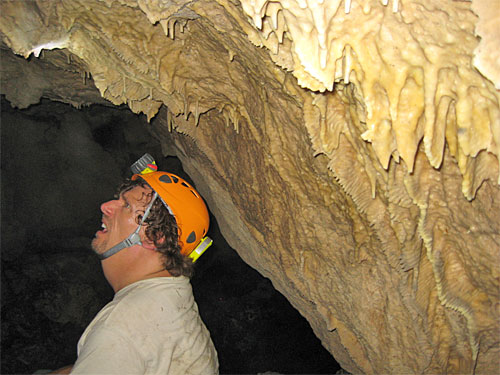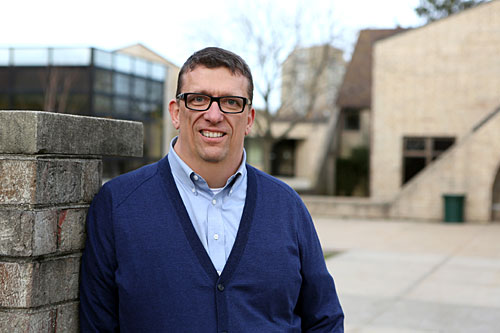What Lies Beneath
Hofstra Professor’s Book on Florida Sinkholes First of its Kind
While preparing a lecture for his next class one late-February morning, Professor Robert Brinkmann found himself sidetracked by a flurry of emails with troubling subject lines:
Florida Man Disappears into Sinkhole
Rescue Crews Try to Reach Sinkhole Victim
Massive Sinkhole Kills Man in Bed
“I was absolutely horrified,” said Dr. Brinkmann, Ph.D., professor of Geology, Environment, and Sustainability, recalling the moment he learned of a 20-foot-deep sinkhole that swallowed a Florida man alive. “My colleagues knew of my research on sinkholes in that region and wanted my take on the incident—all I could express was shock, it is a true tragedy.”
Suddenly, Dr. Brinkmann’s past five years of sinkhole studies took on new urgency, as a panicked public clamored for credible information about this relatively unknown phenomenon.
Dr. Brinkmann’s book “Florida Sinkholes, Science and Policy” (University of Florida Press), due out in July, will be the first of its kind about sinkholes. The book is written for the general public to promote better understanding of the facts and allay fear about these natural depressions.
“As a geologist and non-native resident of Florida, I was interested in the state’s topography and found very little information out there, so I conducted my own investigations,” explained Dr. Brinkmann, who is also Hofstra’s director of sustainability studies.
“Because sinkholes are very common in this region,” he said, “I think it’s worthwhile to educate Floridians and those interested in nature and science about how the terrain contributes to sinkhole formation, how to address growing voids and resulting property damage, as well as to examine current policy for dealing them.”
“Catastrophic sinkholes do occasionally emerge and take lives,” Brinkmann added,“but studies over time reveal that it’s rare. These voids are typically slow growing and often evolve with distinct red flags—what occurred in Tampa is incomprehensible.”
Sinkhole science
The study of sinkhole evolution requires careful examination of growth, changes and shifts in the earth’s physical environment. “My research focuses primarily on urban and suburban sustainability. These studies can help city planners and builders assess land quality for development for example,” said Dr. Brinkmann. “I’m among the few investigators in the country who examine karst topography, the basis for sinkholes.”
Karst topography varies from rolling hills dotted with sinkholes, caves, underground streams and springs, to jagged hills and pinnacle karst found in the tropics. These distinctive landscapes form in humid, tropical regions with plentiful rainfall where bedrock consists of carbonate-rich rock that is easily dissolved, such as limestone. Ten percent of the world is made up of karst terrain, including portions of states like Georgia, Texas, Alabama, Missouri, Kentucky, Tennessee, Pennsylvania and Florida—the only US territory comprising a landscape that is entirely karst.
“Florida’s platform of limestone, created by the remains of tiny sea creatures over thousands of years, is like a sponge,” described Dr. Brinkmann, “it is extremely porous and honeycombed with underground cavities and tunnels that fill with water, contributing to a soft terrain that changes and shifts easily.”
Natural sinkholes occur when acidic rainwater seeps down through surface soil and sediment, eventually reaching soluble or carbonate rock (limestone) beneath. It is a process in which the water gradually dissolves the rock, enlarging its natural fissures, joints, and creating cavities beneath. As the process continues over hundreds of years, the loose ceiling of soil and sand is softened and washed into these cracks and voids. Depending on the thickness of the top layer and how close the void beneath is to the surface, the land may sustain its own weight and whatever is built on top.
But there will come a day, Dr. Brinkmann said, when the surface layer will collapse.
“Like an hourglass, materials and anything above will simply funnel in, forming sinkholes that can be miles wide and very deep as I account in the book, however it’s uncommon,” he said. “Most are relatively small, some a few feet across and a foot deep— the Tampa incident is far from what we typically see.”
Signs and symptoms
Is it possible to detect and prevent a developing sinkhole? In his book, Dr. Brinkmann discusses telltale signs such as doors or windows that no longer close properly, sloping floors, concave driveways, sagging trees and fences, changes in drainage and rainwater collecting in unlikely places. Cracked walls and foundations are also a calling card. Of course, many of these visible problems can be fixed and small sinkholes filled in with grout or concrete, but it can come at a steep price.
“In Florida, it used to be that all homeowners received insurance coverage for sinkholes, now it’s an option and many residents considered high-risk by insurers are often denied,” stated Dr. Brinkmann who was denied coverage for his Florida home. “Sinkholes are a fact of life in Florida—prevention, repair and recovery costs for homeowners can be devastating.”
Compounding the sinkhole problem is global warming, climate changes, and extreme weather patterns, particularly long droughts and persistent rain that can accelerate sinkhole formation. Also factor in man-made pollutants, waste, fertilizers, pesticides and activities such as groundwater pumping, and we can expect to see more sinkholes in karst regions like Florida—including contamination of drinking water via existing sinkholes.
“As we work on sinkhole detection and prevention, it’s also very important to protect existing sinkholes from pollution,” emphasized Dr. Brinkmann, “and we can do this by making sure sinkholes do not become convenient sites for dumping trash and other contaminants.”
He concluded, “Just the mention of ‘sinkhole’ terrifies people especially given an intensely publicized fatality, but I believe research and education is the best way to calm our fears of the unknown.”
“Florida Sinkholes, Science and Policy” will be available July 2013. For more information about Dr. Brinkmann and his work, please visit hofstra.edu/sustainability.




